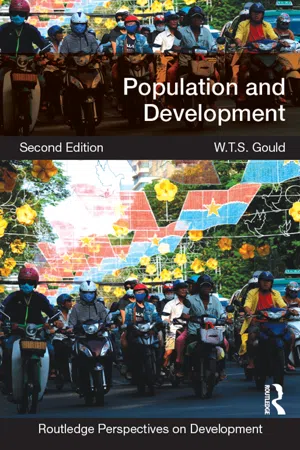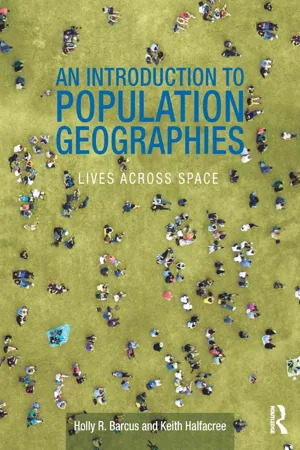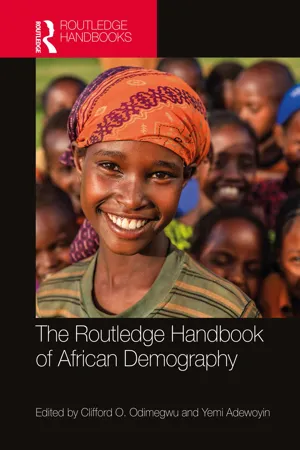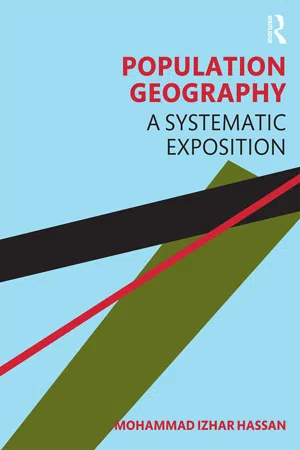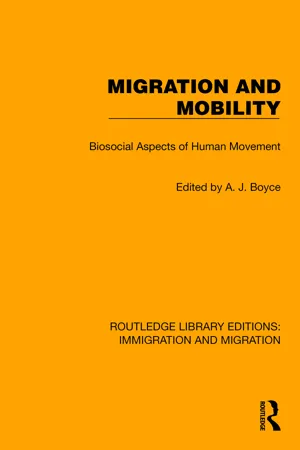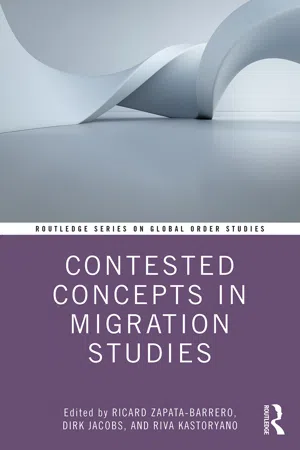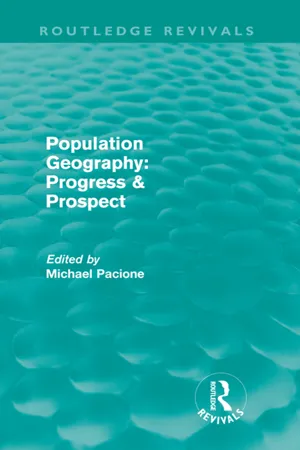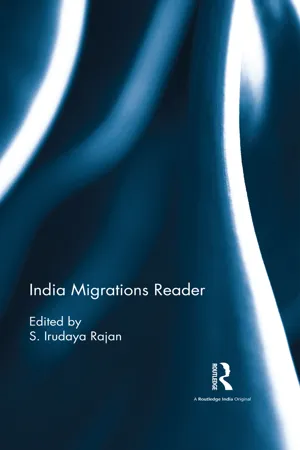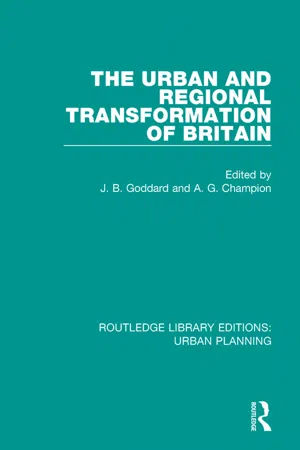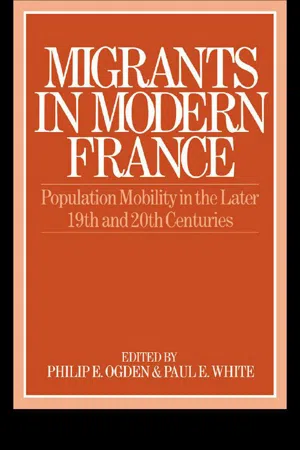Geography
Internal Migration
Internal migration refers to the movement of people within a country, typically from rural to urban areas or between different regions. It is driven by factors such as employment opportunities, better living conditions, and access to services. Internal migration can have significant impacts on population distribution, urbanization, and regional development within a country.
Written by Perlego with AI-assistance
Related key terms
11 Key excerpts on "Internal Migration"
- eBook - ePub
- W.T.S. Gould(Author)
- 2015(Publication Date)
- Routledge(Publisher)
Population movements of all kinds, commonly termed ‘migration’, at the source areas of any move as well as at their destination, affect both the level and the patterns of development; and development affects both the scale and patterns of movement to and from any area. Like mortality and fertility, migration is intrinsically responsive to development, and, like fertility but unlike mortality, usually contains a large element of conscious choice, in this case about whether to move or not. Unlike both fertility and mortality, however, there are no major biological factors directly involved in the decision to move, though clearly the biologically endowed physical strength is an important contributing factor differentiating males and females, and especially young adult males, for the many unskilled labouring tasks undertaken throughout the world by migrant labourers. In principle, therefore, we are dealing with the causes and impacts of human decisions when we consider migration and its relationships with development. Except in the extreme cases of forced migration and for refugees, migrants generally choose to migrate, whether as individuals or as family or other groups.Conceptualising migrationMigration is an intrinsically spatial phenomenon involving movement of individuals and groups across space into and out of an area. The process of movement is therefore about flows, how they are measured and described. However, in any population there will be stocks of migrants, the accumulated number of people who have moved into that population. Usually, movement is conceptualised in terms of flows, but migrant populations are seen as stocks. Differentiating between stocks and flows is central to understanding the migration/development nexus (see Box 6.1 for discussion of the measures and language of migration analysis).Internal and international movements can have similar causes, essentially associated with real or imagined choice by individual migrants. By contrast, however, they can have very different effects at the destinations of the movement. The simple politically based dichotomy of internal/international migration, with a great complexity of movement in space and time, as indicated in the typology of mobility phenomena (Table 6.1 - eBook - ePub
An Introduction to Population Geographies
Lives Across Space
- Holly R. Barcus, Keith Halfacree(Authors)
- 2017(Publication Date)
- Routledge(Publisher)
CHAPTER 5Placing human migration5.1 INTRODUCTION: DEFINING MIGRATION
5.1.1 What is migration?
Migration remains the most widely studied and examined element within Population Geography (Boyle 2003, 2004). Moreover, whilst Geographers have played a pivotal role in shaping our contemporary understanding of it, the topic is of interest to numerous academic disciplines, including Demography, Sociology, Political Science, Economics and Anthropology (Brettell and Hollifield 2008a). In this respect, approaching migration as it occurs within the life course has considerable potential for bringing together a scattered body of scholarship often fragmented by “disciplinary partitioning” (Olwig and Sørensen 2002: 7).But what exactly is migration? Initially put, as in a recent textbook, it is “the movement of people to live in a different place” (Holdsworth et al. 2013: 96) or a “permanent change in residence.” It is residential relocation. Or, as expressed in UK and US censuses, a migration is deemed to have occurred when one’s “usual address” has changed within the last 1 or 5 years, respectively (ONS 2013; USCB 2013). Simple, then, one might think! However, as Holdsworth et al. (2013: 98) also noted, careful consideration of these definitions immediately raises a host of questions: what precisely is meant by “different place,” “live in,” “permanent,” or “usual address”? Consequently, by the end of the present chapter, “migration” will have been demonstrated to be at least as complex and multi-dimensional a concept as Chapter 4 revealed “fertility” to be.Starting with the idea of “different place,” the type of areal unit(s) involved in a migration is an initial important consideration when defining it specifically. A crucial starting point is whether a political boundary is crossed during a move. For example, an individual could move from one county to another within the same US state or from one state to another. Both moves are conventionally described as intra-national or Internal Migration, because neither involves leaving the US. In contrast, a move from the US to Canada, crossing an international border, is an international migration - eBook - ePub
- Clifford O. Odimegwu, Yemi Adewoyin, Clifford O. Odimegwu, Yemi Adewoyin(Authors)
- 2022(Publication Date)
- Routledge(Publisher)
PART 6 MigrationPassage contains an image
29 Internal Migration IN SUB-SAHARAN AFRICA
DOI: 10.4324/9780429287213-35Dynamics, destinations, and implicationsVollan O. Ochieng, Razak M Gyasi, and Blessing U MberuIntroduction
Internal Migration, particularly rural-urban migration, is considered the most common type of population movement in sub-Saharan Africa (SSA) with implications for long-term spatial population distribution, overwhelming emergence of agglomerates, and stimulating concentration of population in the region (Mberu, 2015; World Bank, 1999). Internal Migration can either be voluntary or involuntary. The former includes those pertaining to a migrant’s own pursuit to relocate to another area/region due to perceived or real, better prospects at the preferred destination. Involuntary migration, on the other hand, is induced by factors other than the migrant movement. It includes but is not limited to unwanted job transfers, conflicts, insecurities, and violent displacements at source or home (Oucho, Oucho, & Ochieng, 2014). In addition, Internal Migration takes the form of rural-urban migration, urban-rural migration, and urban-urban migration (Oucho & Oucho, 2015). Migration – internal and international – occurs as a result of individual’s pursuit for better opportunities to counter challenges pertaining to access to better social welfare, health, poverty alleviating economic activities, and environmental quality (International Organization for Migration, 2018a; Mberu, Beguy, & Ezeh, 2017) with implications for migrants’ socio-economic welfare. Migration also presents an implication for improved socio-economic status. Being a coping strategy, migration is largely driven by economic, environmental, political, and demographic factors both at origin and destination (Obuor et al., 2017). It has hence resulted in complex social and demographic policy challenges both at source and destination regions (International Labor Organization, 2018a). Existing evidence indicates that Internal Migration is more widespread than international migration, perhaps due to low-cost implications involved in relocation within a country rather than externally. - eBook - ePub
Population Geography
A Systematic Exposition
- Mohammad Izhar Hassan(Author)
- 2020(Publication Date)
- Routledge India(Publisher)
United Nations Multilingual Demographic Dictionary defines migration as ‘a form of geographical or spatial mobility between one geographic unit and another, generally involving a change in residence from the place of origin or departure, to the place of destination or arrival’. Thus, migration is different from other forms of mobility such as temporary movement of tourists, or frequent trips of people in business, or constant movements of nomads, or movement of students for the purpose of studies, or daily movement of commuters to place of work. These movements do not involve any permanent or semi-permanent change in the place of residence to qualify as migration.The study of migration occupies an important place in population studies, as together with fertility and mortality, migration determines the size, distribution and growth of population along with its composition and characteristics. As compared with the other two components, migration has been a more popular subject of interest for population geographers. Interestingly, demographers have paid very little attention to this component of population change. Population geographers have since long been concerned with the relationships between movement of people, distance and interacting areas (Woods, 1979:165). Along with its various demographic, social and economic effects, population geographers have also been concerned with the environmental influences upon migration streams and consequences in areas of departure and destination (Clarke, 1972:130).Mobility and migration: general terms and concepts
As noted previously, migration refers to permanent or semi-permanent change in the place of residence of an individual or a group of individuals from one location to another. Hence, it is different from the more general term mobility, which refers to all types of movements of people (Rubenstein and Bacon, 1990:75). Thus, the term mobility includes both permanent (and semi-permanent) and temporary movements of people over the earth. With regard to temporary movements, the examples of which have already been cited, a distinction is generally made between a cyclic and a periodic movement. A cyclic movement includes short duration trips to place of work (i.e. commuting), or frequent business trips of people in business, or movement of nomads, which is comparatively irregular in timing. A periodic movement, on the other hand, involves a longer period of residence away from home base than that in the cyclic movement (Blij and Muller, 1986:103). Periodic movement includes the movement of students away to other locations for the purpose of studies, or the movements of military personnel to military bases, training schools or combat zones. The movement of migrant labourers and their families is also periodic movement, although it is more cyclic than that of students or military personnel. Still another form of periodic movement is what is commonly known as transhumance - eBook - ePub
Migration and Mobility
Biosocial Aspects of Human Movement
- A.J. Boyce, A.J. Boyce, A.J. Boyce(Authors)
- 2022(Publication Date)
- Routledge(Publisher)
INTER-URBAN MIGRATION IN BRITAIN: A GEOGRAPHICAL PERSPECTIVE
J.H. JOHNSONDepartment of Geography, University of Lancaster, Bailrigg, Lancaster LA 1 4YW, UKINTRODUCTION
As societies, economies and transport systems become modernized, then more frequent, longer, and more complex movements of population commonly take place. As this spatial mobility of population grows, the resulting diverse movements of population become more and more difficult to fit into an easy typology; but a critical distinction must be made between temporary movements connected with everyday activities and those moves which involve a change of home, with the social and economic costs that this entails (figure 1 ). Not that the two types are independent, since temporary movements provide the opportunity to acquire the information which may lead to permanent migration. For example, retirement moves are often made to resort areas known earlier in life and intra-urban residential moves are frequently made to sectors of the city which are known for other reasons. Focusing on permanent moves (in so far as the term ‘permanent’ can be applied to any population movement in modern urban society), a critical distinction is between those moves which simply involve a change of residence and those which also involve a change in employment (Johnson 1976 ). The study of ‘ labour migration’ – the simultaneous change of job and of home – has taken on greater importance in recent decades for a number of inter-related reasons.FIGURE 1. Some types of population migration.Reduced levels of fertility are leading to parallel falls in natural increase in many parts of the developed world. In Britain, it is likely that the period of relatively rapid population increase since the end of World War II is at last at an end. As a result, population migration of all types is becoming more important in causing changes in population totals and in modifying local population structures. The importance of migration is not merely demographic. In the past many regionally based planning proposals have often assumed that natural increase would more than offset loss by migration. This assumption has usually proved to be true, at least as far as the population totals of major regions are concerned, although not necessarily at a local scale. It could be quite confidently expected that planning errors in the over-provision of houses or jobs could be corrected in the longer term, as total regional population grew. Now, however, mistakes in the allocation of regional investment appear more difficult to adjust (Johnson & Salt 1981 - eBook - ePub
- Ricard Zapata-Barrero, Dirk Jacobs, Riva Kastoryano, Ricard Zapata-Barrero, Dirk Jacobs, Riva Kastoryano(Authors)
- 2021(Publication Date)
- Routledge(Publisher)
Their patterns of migration have changed dramatically with the invention of agriculture, cities, and technologies of transportation that split human societies into large majorities of rural populations leading sedentary lives within the confines of their villages and small mobile populations of traders, soldiers, clerks, and others whose activities required them to travel frequently over considerable distances. The last 300 years have seen a dramatic upheaval of this dominant pattern. Colonialism and slavery displaced large populations in what we now call the Global South and created new settler societies in the Americas, South Africa, and Oceania. The Industrial Revolution uprooted peasants first in Europe and then everywhere, turning them into a mobile workforce. Finally, the modern state system introduced relatively stable territorial borders and permanent populations over whom sovereigns claim to exercise direct rule. With the rise of nationalism since the French Revolution, subjects became nationals of states in whose name governments exercise their power. It is only in this latter context that the figure of the foreigner, which has been present in all recorded human history, becomes that of the migrant who has arrived from another state and is assumed to belong to another nation.This briefest possible summary of anthropological and historical determinants of human movement suggests already that any account that looks at it only as the physical movement of bodies in space must be severely deficient. Yet for a conceptual discussion of migration and mobility it is still useful to start with movement in abstract space and time. In its simplest formula, migration and mobility involve a human being moving between points that can be marked on a map. This geographical movement can be measured by registering the distance between these points and the time it takes to move between them. Measuring movements in this way and analyzing their patterns has been the preoccupation of statistical human geographers from Ernst Georg Ravenstein, the first scholar to postulate ‘laws of migration’ (Ravenstein, 1885 ), to Torsten Hägerstrand, who developed a statistical time-space geography for studying movements ranging from people’s daily commutes to long-distance migration (Hägerstrand, 1975 ).As long as we consider only the physical dimensions of time and space, migration and mobility appear reduced to mere movement and there does not seem any need to further examine their conceptual differences. However, even at this elementary level of analysis, the actual uses and therefore meaning and connotations of the two concepts differ somewhat. We are more likely to employ the term ‘migration’ when movements occur over longer distances and time periods and when they are unidirectional in the sense of leading from A to B and stopping there. By contrast, the term ‘mobility’ will be more frequently applied where movements are over shorter distances and time periods and when they are multidirectional in the sense of onward movement from B to C, return movement from B to A, or patterns of recurrent movement between A and B. - Michael Pacione(Author)
- 2013(Publication Date)
- Routledge(Publisher)
et al ., 1977:29,58,95).If migration is embedded in social relations, the decision to migrate, also, is not arrived at in isolation. Groups, such as family, local community, classmates, evolve patterns of behaviour which are modified over time as experience dictates. Gone are the days when elders disapproved of young men ‘running away’, forcing them literally to abscond in the night. Today, migration is accepted virtually everywhere, and frequently the remittances of migrants furnish villagers with what for them are the luxuries of life. In some cases, and notably in Southern Africa, those who stay in the rural areas have become dependent for their livelihood on the earnings of those who have found urban employment.Once a pattern of migration is established, going to town may become the thing to do, the urban experience takes on positive connotations. Thus, in many parts of the Sudanic belt, young men were expected to have spent one or several spells of seasonal migration in Ghana (Rouch, 1956:194). Such norms usually emphasise the experience to be gained, and the challenge to the young to prove themselves. Sometimes these norms become so generally accepted that individuals are swept along, even when they do not share the economic rationale for going to the city. Migration may, in this way, become the rule for a community. Nonetheless, once economic circumstances change, collective migration behaviour quickly adapts to the new reality.The push from rural areas, and the pull of urban areas, are often distinguished in discussions of migration. Reference to push or pull serves to emphasise the importance of a particular motive in the decision to migrate. Refugees, for example, may be said to be pushed out of their rural homes. During the civil strife that accompanied the Partition of India in 1947, about 16 million people fled across the newly established boundaries; most of those uprooted from rural areas sought a new beginning in cities. War, the man-made calamity, frequently makes rural areas so insecure that peasants pack up and leave for the relative security of cities. During the many years of the blood bath in Indochina, some peasants sought shelter in the cities, though many others were relocated by force. In Indonesia, the independence struggle, as well as regional rebellions after independence, led to a mass exodus from the affected rural areas. Civil wars in Korea, Malaysia, the Southern Sudan, and Zaire made peasants abandon their ancestral lands. In Colombia, La Violencia- eBook - ePub
Britain's Population
Demographic Issues in Contemporary Society
- Steven Jackson(Author)
- 2013(Publication Date)
- Routledge(Publisher)
Other factors which influence patterns of inter-regional movement include population structure. Life-cycle stage is significant in determining who will move and when. A significant amount of migration occurs at ‘transitional’ phases in people’s lives – particularly at the transition between education and employment and the transition between employment and retirement. Young adults are the most mobile group in the population, not only because of the diverse opportunities available for entry into the labour market, but also because of their general lack of commitments of home ownership and family rearing. As a consequence growth regions tend to attract a disproportionate share of young adults, and localities which are losing numbers become unbalanced in their structure. The destinations for retirement migrants similarly reflect the effects of age-specific migration, with an increasing burden placed on the health and social services for the care of an ageing population.Intra-regional mobility
Patterns of population movement between the regions may reflect the longerterm process of population redistribution in Britain. However, the majority of moves are over relatively short distances. Over 70 per cent of moves in Britain are over distances of 10 km or less – most of which would come under the heading of residential relocation rather than migration (Owen and Green 1991). People move house for a variety of reasons, depending on individual circumstances, but it is possible to identify aggregate patterns of movement from the overall volatility of local moves. One of the wellestablished trends is the process of ‘suburbanization’, brought about by a constant drift of population from the central areas of towns and cities towards newer housing developments on the periphery. This is not a new process and can be identified in Britain from the peak period of urban growth in the nineteenth century. - eBook - ePub
- S. Irudaya Rajan(Author)
- 2016(Publication Date)
- Routledge India(Publisher)
Although there was considerable success in achieving economic growth from 2 to 3 per cent of growth in GDP in the pre-reform era to over 6 per cent during 1991–2001, its impact on Internal Migration in general and rural-to-urban migration in particular has not been assessed. The latest Census of India 2001 throws several interesting results in respect to the Internal Migration, its regional pattern and the contribution of rural-to-urban migration in urban growth (Bhagat and Mohanty 2009). The paper argues that push factor has not been more important in influencing Internal Migration. As a result, it is not true that the poor and disadvantaged are migrating more than non-poor and the advantaged. Although migration is emerging as an important phenomenon from economic, political and public health points of views (Bhagat 2008), migration research finds low priority among Indian demographers. This is partly because since the early 1990s with a paradigm shift in the demographic research tilting to the issues of reproductive health, the interest in migration research in general and Internal Migration in particular has dwindled considerably. This is also reflected in the new data-sets, namely Demographic Health Surveys (DHS) – known as National Family Health Surveys (NFHS) – an Indian version of Demographic and Health Survey (DHS), and District Level Health Surveys (DLHS) which did not consider migration as an important variable affecting the health status in general and reproductive health in particular. 1 On the other hand, the wealth of data available in Indian censuses on migration is grossly neglected by Indian demographers who are busy with data collection exercises funded by external agencies (Bose 2003). Thus we find very few recent demographic studies on India’s Internal Migration, its causes and consequences - eBook - ePub
- John Goddard, Anthony Champion(Authors)
- 2018(Publication Date)
- Routledge(Publisher)
9 Migration within and between labour markets S. R. Kennett Introduction Population redistribution is the most fundamental aspect of change in the urban system. At sub-regional scales, as noted in the previous chapter, migration is the more important and variable determinant of population change. Of the British population in 1971, more than 6 million (or one in eight) were recorded as moving at least once during the previous year. About 17.5 million moved in the five-year period 1966–71, equivalent to more than one-third of the total population or about the size of all the conurbations together. Nevertheless, for various reasons outlined in the first section, the importance of migration has tended to be underestimated. This chapter then outlines some of the features of population movement in the urban system, concentrating on the characteristics of differential migration. This leads to a discussion of the implications of population decentralization for local government fiscal issues, a topic which illustrates the pervasive importance of migration trends. The study of migration in the urban system The migration mechanism itself should be seen as a process rather than a set of independent, unrelated actions. Ideally, it should be viewed through a hierarchically ordered, interacting urban system, instead of a number of discrete towns, cities and rural areas. The temporal dimension is also vital. The influence of previous population distributions and movements should not be overlooked in an analysis of recent trends. The essential characteristics of the present regional population distribution were shaped in the period between the mid-eighteenth century and the First World War. Changes since then have predominantly affected intraregional population patterns - eBook - ePub
- Philip E. Ogden, Paul White(Authors)
- 2002(Publication Date)
- Routledge(Publisher)
However, the lowest mobility rates of all were amongst those with a close tie to local property—namely farmers and self-employed artisans and shopkeepers. In addition to these variations in the propensity to move, there were also variations between social groups in the distances moved by those who were mobile. Farmers who moved for the most part stayed in the same commune. On the other hand, upper management migrants tended to make long-distance moves between one region and another. Those in the intermediate professions chiefly made relatively short-distance moves without crossing the boundaries of their original départements. Manual workers were second only to farmers in the narrowness of their migration fields. This occupation-specific nature of recent migration is linked to certain changes in the overall direction of migration flows referred to earlier. Recent movement has tended to involve migration into owner-occupied sectors of the housing market. This fact is connected to the counterurbanization trends mentioned earlier. Movers into rural communes from all social classes were predominantly moving into owner-occupied property, two-thirds of it built during the same intercensal period. In contrast rented property (and particularly new rented property) was much less available in rural areas. Consequently the moves of those in the intermediate professions, and the lower white collar and manual sectors, were much more confined to urban areas where the rented property they could afford was more likely to be found. 2.4 The significance of Internal Migration In comparison with her closest neighbours, France is singled out by the fact that throughout the latter half of the nineteenth century, and during the twentieth up to the end of World War II, Internal Migration took place against a background of the lowest natural population growth rates in western Europe
Index pages curate the most relevant extracts from our library of academic textbooks. They’ve been created using an in-house natural language model (NLM), each adding context and meaning to key research topics.
